| VARIETY |
DESCRIPTION |
| 1. Betel vine |
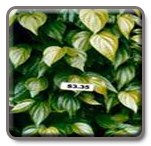 |
| SGM 1 (1994) |
|
It is a clonal selection from a Palghat type. It is adaptable to all betel vine-growing areas of Tamil Nadu. It produces a higher leaf yield of 109 lakh leaves per hectare in a crop duration of 2 to 2½ years. The vines are dwarf stature with vigorous bushy growth having thick hardy stem with short internodes and multilateral. Leaves are attractive yellowish green colour with desirable pungency. It is the first betel vine variety released by TNAU from Southern India. |
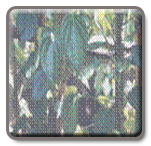 |
| SGM (BV) 2 (2004) |
|
This is a pureline selection from Dindigul local. It possess multilateral vines (17-20/vine) with long petioles and attractive dark green leaves. The leaves are moderately pungent with good chewing quality. It is a high yielder with good market appeal. The duration of the crop is 2-2½ years. The suitable season for cultivation was January – March and June – August for Agathi and March – May and August – October for betelvine. The crop is moderately resistant to phytopthora wilt, blight and nematodes. It yields about 49 lakh leaves / ha / year which is 25.4% increase over SGM 1, 33.8% increase over Karpoori and 62.0% increase over vellaikodi. It can be cultivated all over Tamil Nadu and suitable for open trench cultivation. |
Top |
| 2. Cashew nut |
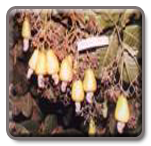 |
| VRI 1 (1981) |
|
It is a clonal selection from germplasm accession maintained at Regional Research Station, Virdhachalam. The average annual yield is 7.12 kg per tree in a year. It yields 1700 kg nuts/kg, having a nut weight of 5g, shelling percentage of 20 % and 5 to 7 fruits/panicle. It is an intensive branching type. The kernels are of high quality (240 W. counts) |
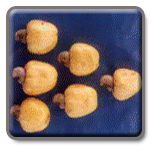 |
| VRI 2 (1985) |
|
It is a selection from Kattupalli village in Chengalpattu district. The parents are the seedling progenies of M.44/3 of the high yielding tree No.1668. It yields 1750 kg of nuts/ha, which is 14.2% higher yield than VRL.1. Nuts are big with a high shelling percentage of 28%. It is resistant to tea mosquito bug and drought. The nut weight is 5g with 5-8 fruits per panicle. Single tree yield is about 8 kg per year. Exhibits less variation on seed propagation. The nut size is 3.4 x 2.6 cm. One hundred nuts weigh 512g. The nuts contain 32.5% protein, 10.3% sugars, 28.7% starch and 47% fat. |
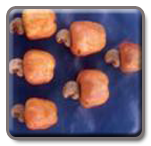 |
| VRI 3 (1991) |
|
It is a seedling progeny (M 26-2) of a high yielding tree (No. 1602) selected from a village Edayanchavadi of Vanur Block of South Arcot District recording a mean yield of 14.19 kg per tree per year as against 9.24 kg and 7.80 kg by VRI 1 and VRI 2 respectively. The increase in yield was 53.57% and 81.92% over VRI 1 and VRI 2 respectively. The tree is medium sized with a height of 5.00 m and spread of 10.30m East – West and 8.10 m North – South at the age of 10 years. The colour of new shoot is light green having dark green mature leaves with prominent venation. Panicles are conical in shape with a length of 17.5 and basal spread of 26 cm. The variety has 0.08 per cent perfect flowers. At pea stage the apple is pinkish green and turns to pink at maturity. The apple is pear shape with a mean weight of 50.8 g. Nuts are large in size with 3.6 cm length and 2.7 cm width. 100 nuts weigh 718 g with a shelling percentage of 29.1. |
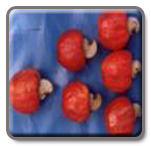 |
| VRI 4 (2000) |
|
It is a selection from Vazhisodanipalayam of Cuddalore taluk of Tamil Nadu released from Regional Research Station, Virudhachalam. The crop yields 3320 kg of nuts per hectare. The nuts are medium in size, each weighing on an average of 6.63 g. Each tree yields as high as 18.10 kg of nuts against 1.84 and 7.92 kg/tree by VRI 3 and VRI 2 respectively. The nuts have a shelling percentage of 28.5. The flowers appear during January – May and crop matures during April – June. The variety is suitable to grow under low rainfall tracts of Tuticorin, Tirunelveli, Sivagangai, Madurai, Theni, Dindigul, Perambalore, Pudukkottai and Cuddalore districts of Tamil Nadu. Also, suitable to grow in all types of soil (red loam to laterite) except water logging black cotton soil and alkaline soils. |
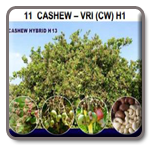 |
| VRI (CW) H1(2009) |
|
- Cluster bearing (6-10 fruits/panicle)
- Bold nuts (7.2 g) and kernel (2.2 g)
- High shelling (30.5%)
- Suitable for export (W 210 grade)
- Easy peeling testa
- Yield - 14.5 kg/tree, 2900 kg/ha
|
Top |
| 3. Coconut |
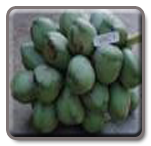 |
| VHC 1 (1982) |
|
It is a hybrid between East Coast Tall and Malayan Dwarf Green. It’s pre bearing age is 4 years, with an yield of 98 nuts/palm/year. Copra content per fruit is 135 g with an oil content of 70 per cent.
|
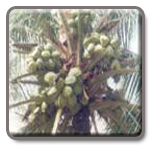 |
| VHC 2 (1988) |
|
It is a hybrid evolved by crossing, East Coast Tall and Malaysian Yellow Dwarf at Veppankulam. It yields more than 100 nuts per tree per year, which is 55% higher than local varieties and 8% over VHC 1. It yields as much copra yield as VHC 1 with 11% higher oil content. The buckling of leaves and bunches is negligible with a high degree of stability. |
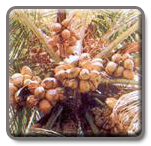 |
| VHC 3 (2000) |
|
VHC 3 (East Coast Tall x Malaysian Orange Dwarf) records a mean yield of 156 nut/palm/year and copra yield of 25.2 kg/palm/year with an increased nut yield of 10 per cent and copra yielded 19.7 per cent over VHC 2. Oil content is 70 per cent. The estimated oil yield is 2.55 tonnes / ha as against 2.13 and 1.13 tonnes/ha in VHC 2, ECT respectively. High nut weight, kernel weight and copra weight are the special features of VHC 3. The hybrid recorded high copra out turn of 162 g/nut as against 146 g in VHC 2. For one tonne of copra it requires 6180 nuts, whereas VHC 2 and ECT requires 7680 and 6675 nuts respectively. |
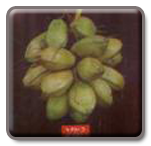 |
| VPM 3 (1994) |
|
It is a selection from material received from CPCR, Kasaragod, Kerala. It yields 72-92 nuts and 15 kg copra per palm per year with high oil content. The duration is 80-100 years and suited to all districts of Tamil Nadu. |
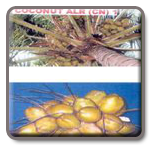 |
| ALR (CN) 1 (2002) |
|
It is single line selection from Arasampatti tall (Darumapuri district) released from Coconut Research Station, Aliyar nagar. This variety comes to bearing in five years of planting and continues to bear and yield well up to 80 years. It is a drought tolerant, early bearer (5 years), high yielding, tall variety. 7645 nuts give one-ton copra. This variety tolerates the incidence of important pests of coconut. It is suitable under both rainfed and irrigated conditions. |
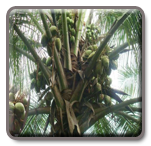 |
| ALR 2 (2010) |
|
- Selection from Tiptur TallNut bearing in 5½ years
- Regular bearing habit
- 12 inflorescences per year
- Weight of copra - 135 g/nut
- 2.57 tonnes of copra per hectare
- 7400 nuts required to make one tonne of copra
- Oil content 64.7 percent
- Possesses drought tolerance
- Moderately resistant to rhinoceros beetle, red palm weevil and leaf blight
- Yield - 140 nuts / palm / year
|
Top |
| 4. Palmyrah |
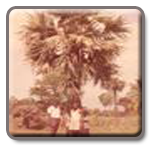 |
| SVPR 1 (1992) |
|
It is a selection from Srivilliputhur local. It is semi tall in height and tapping duration is up to 95 days. It is suitable for growing in entire Tamil Nadu. it yields 298 litres of padaneer/tree/year. The Jaggaery recovery is higher (144 g Jaggery/lit of padaneer). |
Top |